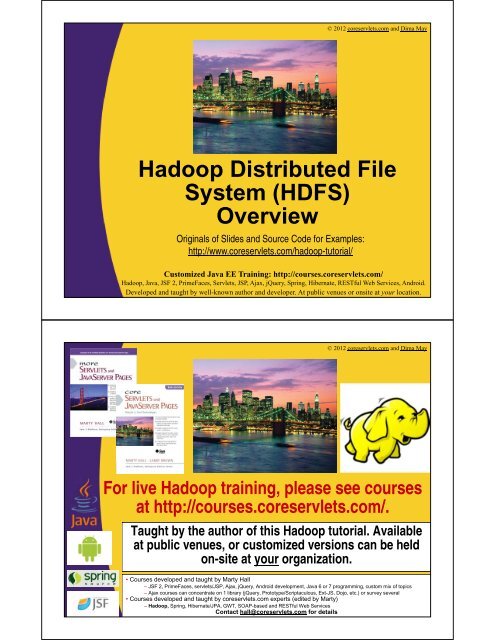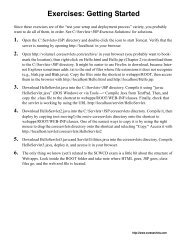HDFS - Custom Training Courses - Coreservlets.com
HDFS - Custom Training Courses - Coreservlets.com
HDFS - Custom Training Courses - Coreservlets.com
You also want an ePaper? Increase the reach of your titles
YUMPU automatically turns print PDFs into web optimized ePapers that Google loves.
© 2012 coreservlets.<strong>com</strong> and Dima MayHadoop Distributed FileSystem (<strong>HDFS</strong>)OverviewOriginals of Slides and Source Code for Examples:http://www.coreservlets.<strong>com</strong>/hadoop-tutorial/<strong>Custom</strong>ized Java EE <strong>Training</strong>: http://courses.coreservlets.<strong>com</strong>/Hadoop, Java, JSF 2, PrimeFaces, Servlets, JSP, Ajax, jQuery, Spring, Hibernate, RESTful Web Services, Android.Developed and taught by well-known author and developer. At public venues or onsite at your location.© 2012 coreservlets.<strong>com</strong> and Dima MayFor live Hadoop training, please see coursesat http://courses.coreservlets.<strong>com</strong>/.Taught by the author of this Hadoop tutorial. Availableat public venues, or customized versions can be heldon-site at your organization.• <strong>Courses</strong> developed and taught by Marty Hall– JSF 2, PrimeFaces, servlets/JSP, Ajax, jQuery, Android development, Java 6 or 7 programming, custom mix of topics– Ajax courses <strong>Custom</strong>ized can concentrate Java on 1 EE library <strong>Training</strong>: (jQuery, Prototype/Scriptaculous, http://courses.coreservlets.<strong>com</strong>/Ext-JS, Dojo, etc.) or survey several• <strong>Courses</strong> developed and taught by coreservlets.<strong>com</strong> experts (edited by Marty)Hadoop, Java, JSF 2, PrimeFaces, Servlets, JSP, Ajax, jQuery, Spring, Hibernate, RESTful Web Services, Android.– Hadoop, Spring, Hibernate/JPA, GWT, SOAP-based and RESTful Web ServicesDeveloped and taught by well-known Contact author hall@coreservlets.<strong>com</strong> and developer. At public for details venues or onsite at your location.
Agenda• Introduction• Architecture and Concepts• Access Options4<strong>HDFS</strong>• Appears as a single disk• Runs on top of a native filesystem– Ext3,Ext4,XFS• Based on Google's Filesystem GFS• Fault Tolerant– Can handle disk crashes, machine crashes, etc...• Based on Google's Filesystem (GFS orGoogleFS)– gfs-sosp2003.pdf– http://en.wikipedia.org/wiki/Google_File_System5
Use Commodity Hardware• “Cheap” Commodity Server Hardware– No need for super-<strong>com</strong>puters, use <strong>com</strong>modity unreliablehardware– Not desktops!NOTBUT6<strong>HDFS</strong> is Good for...• Storing large files– Terabytes, Petabytes, etc...– Millions rather than billions of files– 100MB or more per file• Streaming data– Write once and read-many times patterns– Optimized for streaming reads rather than random reads– Append operation added to Hadoop 0.21• “Cheap” Commodity Hardware– No need for super-<strong>com</strong>puters, use less reliable<strong>com</strong>modity hardware7
<strong>HDFS</strong> is not so good for...• Low-latency reads– High-throughput rather than low latency for small chunksof data– HBase addresses this issue• Large amount of small files– Better for millions of large files instead of billions ofsmall files• For example each file can be 100MB or more• Multiple Writers– Single writer per file– Writes only at the end of file, no-support for arbitraryoffset8<strong>HDFS</strong> Daemons• Filesystem cluster is manager by three types ofprocesses– Namenode• manages the File System's namespace/meta-data/file blocks• Runs on 1 machine to several machines– Datanode• Stores and retrieves data blocks• Reports to Namenode• Runs on many machines– Secondary Namenode• Performs house keeping work so Namenode doesn’t have to• Requires similar hardware as Namenode machine• Not used for high-availability – not a backup for Namenode9
<strong>HDFS</strong> DaemonsSecondaryNamenodeNamenodeManagementNodeManagementNodeDatanodeDatanode Datanode Datanode...Node 1 Node 2 Node 3 Node N10Files and Blocks• Files are split into blocks (single unit ofstorage)– Managed by Namenode, stored by Datanode– Transparent to user• Replicated across machines at load time– Same block is stored on multiple machines– Good for fault-tolerance and access– Default replication is 311
Files and Blockshamlet.txt file =Block #1 (B1) + Block #2 (B2)NamenodeSAME BLOCKManagementNodeB1B2B1B2B2B1DatanodeDatanodeDatanodeDatanodeDatanode12Rack #1Rack #N<strong>HDFS</strong> Blocks• Blocks are traditionally either 64MB or128MB– Default is 64MB• The motivation is to minimize the cost ofseeks as <strong>com</strong>pared to transfer rate– 'Time to transfer' > 'Time to seek'• For example, lets say– seek time = 10ms– Transfer rate = 100 MB/s• To achieve seek time of 1% transfer rate– Block size will need to be = 100MB13
Block Replication• Namenode determines replica placement• Replica placements are rack aware– Balance between reliability and performance• Attempts to reduce bandwidth• Attempts to improve reliability by putting replicas onmultiple racks– Default replication is 3• 1st replica on the local rack• 2nd replica on the local rack but different machine• 3rd replica on the different rack– This policy may change/improve in the future14Client, Namenode, andDatanodes• Namenode does NOT directly write or readdata– One of the reasons for <strong>HDFS</strong>’s Scalability• Client interacts with Namenode to updateNamenode’s <strong>HDFS</strong> namespace and retrieveblock locations for writing and reading• Client interacts directly with Datanode toread/write data15
Namenode Memory Concerns18• For fast access Namenode keeps all blockmetadata in-memory– The bigger the cluster - the more RAM required• Best for millions of large files (100mb or more) rather thanbillions• Will work well for clusters of 100s machines• Hadoop 2+– Namenode Federations• Each namenode will host part of the blocks• Horizontally scale the Namenode– Support for 1000+ machine clusters• Yahoo! runs 50,000+ machines– Learn more @ http://hadoop.apache.org/docs/r2.0.2-alpha/hadoop-yarn/hadoop-yarn-site/Federation.htmlNamenode Memory Concerns• Changing block size will affect how muchspace a cluster can host– 64MB to 128MB will reduce the number of blocks andsignificantly increase how much space the Namenodewill be able to support– Example:• Let’s say we are storing 200 Terabytes = 209,715,200 MB• With 64MB block size that equates to 3,276,800 blocks– 209,715,200MB / 64MB = 3,276,800 blocks• With 128MB block size it will be 1,638,400 blocks– 209,715,200MB / 128MB = 1,638,400 blocks19
Namenode's fault-tolerance• Namenode daemon process must be running atall times– If process crashes then cluster is down• Namenode is a single point of failure– Host on a machine with reliable hardware (ex. sustain a diskfailure)– Usually is not an issue• Hadoop 2+– High Availability Namenode• Active Standby is always running and takes over in case mainnamenode fails• Still in its infancy– Learn more @ http://hadoop.apache.org/docs/r2.0.2-alpha/hadoop-yarn/hadoop-yarn-site/<strong>HDFS</strong>HighAvailability.html20<strong>HDFS</strong> Access• Access Patterns– Direct• Communicate with <strong>HDFS</strong> directly through native client• Java, C++– Proxy Server• Access <strong>HDFS</strong> through a Proxy Server – middle man• REST, Thrift, and Avro Servers21
Direct Access• Java and C++ APIs• Clients retrievemetadata such asblocks’ locationsfrom Namenode• Client directlyaccess datanode(s)• Java API– Most <strong>com</strong>monly used– Covered in this course• Used byMapReduceJava ClientJava Client...Java ClientNamenodeDatanodeDatanode...Datanode22Source: White, Tom. Hadoop The Definitive Guide. O'Reilly Media. 2012Proxy Based Access• Clients <strong>com</strong>municate through a proxy– Strives to be language independent• Several Proxy Servers are packaged withHadoop:– Thrift – interface definition language– Web<strong>HDFS</strong> REST – response formatted in JSON, XML orProtocol Buffers– Avro – Data Serialization mechanismClientClientProxyServerNamenodeDatanode...ClientProxyServer...Datanode23Source: White, Tom. Hadoop The Definitive Guide. O'Reilly Media. 2012
Resources: BooksHadoop: The Definitive Guide<strong>HDFS</strong> ChaptersTom White (Author)O'Reilly Media; 3rd Edition (May6, 2012)Hadoop in Action<strong>HDFS</strong> ChapterChuck Lam (Author)Manning Publications; 1st Edition (December, 2010)Hadoop Operations<strong>HDFS</strong> ChaptersEric Sammer (Author)O'Reilly Media (October 22, 2012)24Resources: BooksHadoop in Practice<strong>HDFS</strong> ChaptersAlex Holmes (Author)Manning Publications; (October 10, 2012)25
Resources• Home Page– http://hadoop.apache.org• Mailing Lists– http://hadoop.apache.org/mailing_lists.html• Wiki– http://wiki.apache.org/hadoop• Documentation is sprinkled across manypages and versions:– http://hadoop.apache.org/docs/hdfs/current– http://hadoop.apache.org/docs/r2.0.2-alpha/– <strong>HDFS</strong> Guides: http://hadoop.apache.org/docs/r0.20.226© 2012 coreservlets.<strong>com</strong> and Dima MayWrap-Up<strong>Custom</strong>ized Java EE <strong>Training</strong>: http://courses.coreservlets.<strong>com</strong>/Hadoop, Java, JSF 2, PrimeFaces, Servlets, JSP, Ajax, jQuery, Spring, Hibernate, RESTful Web Services, Android.Developed and taught by well-known author and developer. At public venues or onsite at your location.
Summary• We learned about– <strong>HDFS</strong> Use Cases– <strong>HDFS</strong> Daemons– Files and Blocks– Namenode Memory Concerns– Secondary Namenode– <strong>HDFS</strong> Access Options28© 2012 coreservlets.<strong>com</strong> and Dima MayQuestions?JSF 2, PrimeFaces, Java 7, Ajax, jQuery, Hadoop, RESTful Web Services, Android, Spring, Hibernate, Servlets, JSP, GWT, and other Java EE training.<strong>Custom</strong>ized Java EE <strong>Training</strong>: http://courses.coreservlets.<strong>com</strong>/Hadoop, Java, JSF 2, PrimeFaces, Servlets, JSP, Ajax, jQuery, Spring, Hibernate, RESTful Web Services, Android.Developed and taught by well-known author and developer. At public venues or onsite at your location.
















